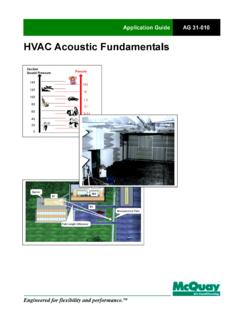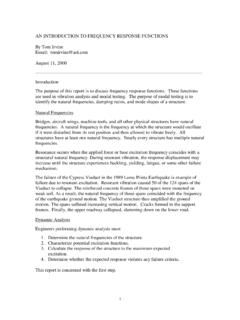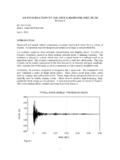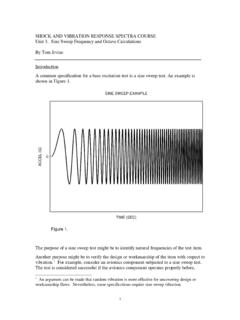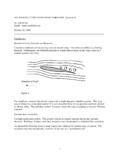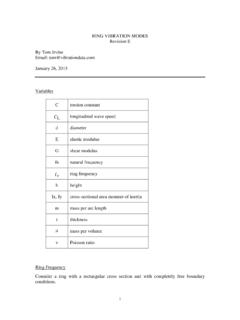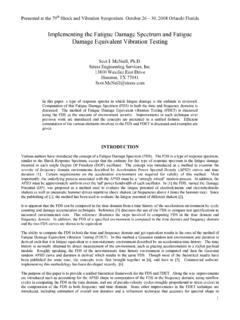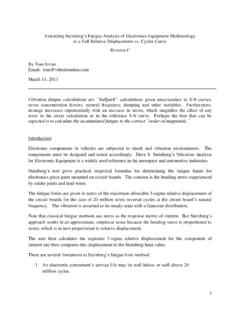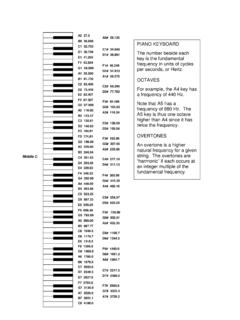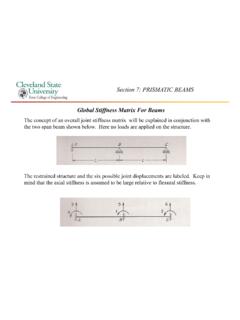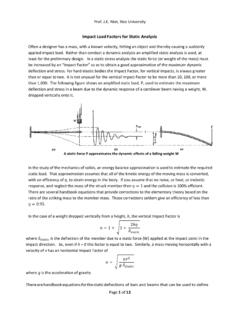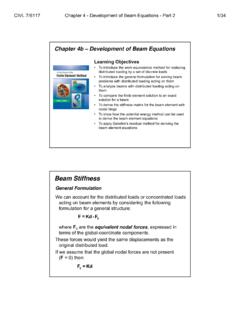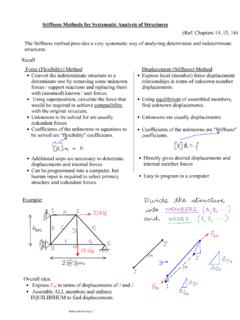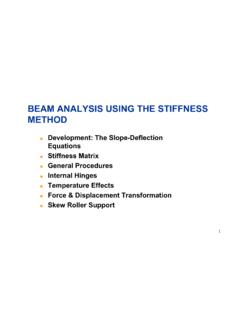Transcription of BENDING FREQUENCIES OF BEAMS, RODS, AND PIPES …
1 1 BENDING FREQUENCIES OF BEAMS, RODS, AND PIPES Revision S By Tom Irvine Email: November 20, 2012 _____ Introduction The fundamental FREQUENCIES for typical beam configurations are given in Table 1. Higher FREQUENCIES are given for selected configurations. Table 1. Fundamental BENDING FREQUENCIES Configuration Frequency (Hz) Cantilever f1 = f2 = f1 f3 = f1 Cantilever with End Mass m f1 = Simply-Supported at both Ends (Pinned-Pinned) fn = EILn212, n=1, 2, 3, .. Free-Free f1 = 0 (rigid-body mode) f2 = f3 = f1 f4 = f1 2 Table 1. Fundamental BENDING FREQUENCIES (continued) Configuration Frequency (Hz) Fixed-Fixed Same as free-free beam except there is no rigid-body mode for the fixed-fixed beam .
2 Fixed - Pinned f1 = where E is the modulus of elasticity I is the area moment of inertia L is the length is the mass density (mass/length) P is the applied force Note that the free-free and fixed-fixed have the same formula. The derivations and examples are given in the appendices per Table 2. Table 2. Table of Contents Appendix Title Mass Solution A Cantilever beam I End mass. beam mass is negligible Approximate B Cantilever beam II beam mass only Approximate C Cantilever beam III Both beam mass and the end mass are significant Approximate D Cantilever beam IV beam mass only Eigenvalue E beam Simply-Supported at Both Ends I Center mass.
3 beam mass is negligible. Approximate F beam Simply-Supported at Both Ends II beam mass only Eigenvalue 3 Table 2. Table of Contents (continued) Appendix Title Mass Solution G Free-Free beam beam mass only Eigenvalue H Steel Pipe example, Simply Supported and Fixed-Fixed Cases beam mass only Approximate I Rocket Vehicle Example, Free-free beam beam mass only Approximate J Fixed-Fixed beam beam mass only Eigenvalue K Fixed-Pinned beam beam mass only Eigenvalue Reference 1. T. Irvine, Application of the Newton-Raphson Method to Vibration Problems, Revision E, Vibrationdata, 2010. 4 APPENDIX A Cantilever beam I Consider a mass mounted on the end of a cantilever beam .
4 Assume that the end-mass is much greater than the mass of the beam . Figure A-1. E is the modulus of elasticity. I is the area moment of inertia. L is the length. g is gravity. m is the mass. The free-body diagram of the system is Figure A-2. R is the reaction force. MR is the reaction BENDING moment. Apply Newton s law for static equilibrium. forces0 (A-1) R - mg = 0 (A-2) mg R MR L m EI g L 5 R = mg (A-3) At the left boundary, moments0 (A-4) MR - mg L = 0 (A-5)
5 MR = mg L (A-6) Now consider a segment of the beam , starting from the left boundary. Figure A-3. V is the shear force. M is the BENDING moment. y is the deflection at position x. Sum the moments at the right side of the segment. moments0 (A-7) MR - R x - M = 0 (A-8) M = MR - R x (A-9) The moment M and the deflection y are related by the equation MEIy (A-10) V R MR M x y 6 EIyMRRx (A-11)
6 EIymgLmgx (A-12) EIymgLx (A-13) ymgEILx (A-14) Integrating, ymgEILxxa22 (A-15) Note that a is an integration constant. Integrating again, yxmgEILxxaxb() 2236 (A-16) A boundary condition at the left end is y(0) = 0 (zero displacement) (A-17) Thus b = 0 (A-18) Another boundary condition is y'00 (zero slope) (A-19)
7 7 Applying the boundary condition to equation (A-16) yields, a = 0 (A-20) The resulting deflection equation is yxmgEILxx() 2236 (A-21) The deflection at the right end is yLmgEILLL() 2236 (A-22) yLmgLEI() 33 (A-23) Recall Hooke s law for a linear spring, F = k y (A-24) F is the force.
8 K is the stiffness . The stiffness is thus k = F / y (A-25) The force at the end of the beam is mg. The stiffness at the end of the beam is kmgmgLEI 33 (A-26) kEIL 33 (A-27) 8 The formula for the natural frequency fn of a single-degree-of-freedom system is mk21fn (A-28) The mass term m is simply the mass at the end of the beam .
9 The natural frequency of the cantilever beam with the end-mass is found by substituting equation (A-27) into (A-28). 3mLEI321fn (A-29) 9 APPENDIX B Cantilever beam II Consider a cantilever beam with mass per length . Assume that the beam has a uniform cross section. Determine the natural frequency. Also find the effective mass, where the distributed mass is represented by a discrete, end-mass. Figure B-1. The governing differential equation is EIyxyt 4422 (B-1) The boundary conditions at the fixed end x = 0 are y(0) = 0 (zero displacement) (B-2) dydxx 00 (zero slope) (B-3) The boundary conditions at the free end x = L are dydxxL220 (zero BENDING moment) (B-4) dydxxL330 (zero shear force) (B-5)
10 Propose a quarter cosine wave solution. EI, L 10 yxyoxL()cos 12 (B-6) dydxyoLxL 22sin (B-7) dydxyoLxL22222 cos (B-8) dydxyoxLxL33232 sin (B-9) The proposed solution meets all of the boundary conditions expect for the zero shear force at the right end. The proposed solution is accepted as an approximate solution for the deflection shape, despite one deficiency. The Rayleigh method is used to find the natural frequency.
